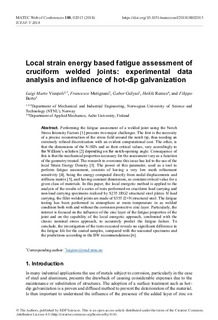| dc.contributor.author | Viespoli, Luigi Mario | |
| dc.contributor.author | Mutignani, Francesco | |
| dc.contributor.author | gulyas, gabor | |
| dc.contributor.author | remes, heikki | |
| dc.contributor.author | Berto, Filippo | |
| dc.date.accessioned | 2019-02-18T15:41:33Z | |
| dc.date.available | 2019-02-18T15:41:33Z | |
| dc.date.created | 2018-08-13T13:12:14Z | |
| dc.date.issued | 2018 | |
| dc.identifier.citation | MATEC Web of Conferences. 2018, . | nb_NO |
| dc.identifier.issn | 2261-236X | |
| dc.identifier.uri | http://hdl.handle.net/11250/2586067 | |
| dc.description.abstract | Performing the fatigue assessment of a welded joint using the Notch Stress Intensity Factors [1] presents two major challenges. The first is the necessity of a precise reconstruction of the stress field around the notch tip, thus needing an extremely refined discretization with an evident computational cost. The other, is that the dimensions of the N-SIFs and so their critical values, vary accordingly to the William’s solution [2] depending on the notch-opening angle. Consequence of this is that the mechanical properties necessary for the assessment vary as a function of the geometry treated. The research to overcome this issue has led to the use of the local Strain Energy Density [3]. The power of this parameter, used as a tool to perform fatigue assessment, consists of having a very low mesh refinement sensitivity [4], being the energy computed directly from nodal displacements and stiffness matrix [5], and having constant dimensions, so constant critical value for a given class of materials. In this paper, the local energetic method is applied to the analysis of the results of a series of tests performed on cruciform load carrying and non-load carrying specimens realized by S235 JRG2 structural steel plates. If load carrying, the fillet welded joints are made of S355 J2+N structural steel. The fatigue testing has been performed in atmosphere at room temperature in as welded condition both with and without the corrosion protective zinc layer. Particularly, the interest is focused on the influence of the zinc layer of the fatigue properties of the joint and on the capability of the local energetic approach, confronted with the classic nominal stress approach, to accurately predict the fatigue failure. To conclude, the investigation of the tests executed reveals no significant difference in the fatigue life for the coated samples, compared with the uncoated specimens and the predictions according to the IIW recommendations [6]. | nb_NO |
| dc.language.iso | eng | nb_NO |
| dc.publisher | EDP Sciences | nb_NO |
| dc.rights | Navngivelse 4.0 Internasjonal | * |
| dc.rights.uri | http://creativecommons.org/licenses/by/4.0/deed.no | * |
| dc.title | Local strain energy based fatigue assessment of cruciform welded joints: experimental data analysis and influence of hot-dip galvanization | nb_NO |
| dc.title.alternative | Local strain energy based fatigue assessment of cruciform welded joints: experimental data analysis and influence of hot-dip galvanization | nb_NO |
| dc.type | Journal article | nb_NO |
| dc.type | Peer reviewed | nb_NO |
| dc.description.version | publishedVersion | nb_NO |
| dc.source.pagenumber | 8 | nb_NO |
| dc.source.volume | 188 | nb_NO |
| dc.source.journal | MATEC Web of Conferences | nb_NO |
| dc.identifier.doi | 10.1051/matecconf/201818802013 | |
| dc.identifier.cristin | 1601518 | |
| dc.description.localcode | © The Authors, published by EDP Sciences, 2018. This is an Open Access article distributed under the terms of the Creative Commons Attribution License (http://creativecommons.org/licenses/by/4.0), which permits unrestricted use, distribution, and reproduction in any medium, provided the original work is properly cited. | nb_NO |
| cristin.unitcode | 194,64,92,0 | |
| cristin.unitname | Institutt for maskinteknikk og produksjon | |
| cristin.ispublished | true | |
| cristin.fulltext | original | |
| cristin.qualitycode | 1 | |

